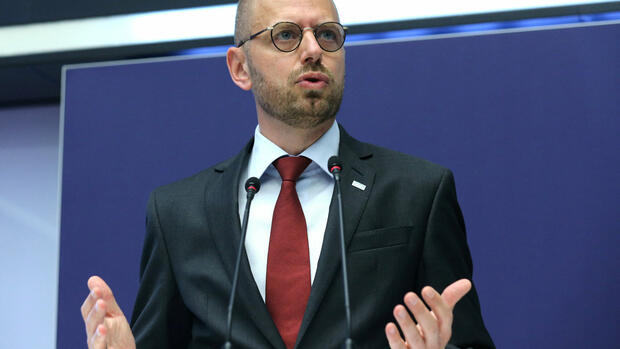The boss of Siemens Energy considers the problems at the wind power subsidiary Gamesa to be serious but solvable.
(Photo: Reuters)
Munich After another warning of drastic quality problems at the wind power subsidiary Gamesa, the share of the Dax group Siemens Energy started trading on Friday with a record loss. The papers collapsed by up to 35.8 percent to 15.02 euros.
On Thursday evening, Siemens Energy dropped its earnings forecast for the current fiscal year because of the quality problems at Gamesa. The Dax group now fears even higher losses than previously forecast anyway.
According to Siemens Energy, a restructuring of Gamesa is still possible despite drastic quality problems. “I believe in a positive wind business,” said CEO Christian Bruch on Friday. In his opinion, the problems can be solved. He takes the subject “extremely seriously”. Bruch left open whether there would be strategic changes. “We’ll look at everything.”
>> Read here: Three maps show where Germany’s drivers of the energy transition are located
Siemens Gamesa boss Jochen Eickholt, an experienced renovator, said he had never experienced a situation like this before. “The quality problems go well beyond what was previously known.” The issue will be approached systematically. “But that costs time and money.” The turnaround will therefore take longer than expected.
The company had reviewed the installed fleet of wind turbines and the product design due to excessive failure rates for wind turbine components. According to Eickholt, some of the turbines showed, among other things, “abnormal vibration behavior”. The Gamesa boss emphasized that it was “a fraction of the fleet”. However, it is not easy to estimate how many wind turbines will actually fail in the next ten to 15 years.
The Spanish-German provider is struggling with serious quality problems.
(Photo: REUTERS)
According to the first conservative estimates, the burdens are more than one billion euros – spread over several years.
Siemens Gamesa has been dragging the entire group down for years with high losses and constant new negative surprises. Since the spin-off from Siemens, the young group has only made losses.
Siemens Energy has already had to lower its earnings forecast several times
In order to be able to take better action, Siemens Energy first sent Eickholt to Madrid as a reorganizer and then took over the company completely. “The 100 percent takeover will help,” said Bruch.
The Siemens Energy boss had already had to lower the yield forecast several times. Originally, the group wanted to significantly reduce the previous year’s loss of 647 million euros in the current financial year, which ends on September 30th.
After a weak first quarter, Bruch then temporarily expected a net loss at the previous year’s level. In May, he then assumed that the loss “will exceed the level of the previous year by up to a low three-digit million amount”. Now this forecast is also waste. Siemens Energy is now expecting significantly higher losses than in the previous year.
Many problems are homemade
Siemens Energy did not want to make a new forecast yet. An exact assessment of the possible financial consequences of the quality problems is not yet possible. The group emphasized that the other businesses, such as electricity grids and gas-fired power plants, continue to do well. The sales forecast for the entire group also continues to apply.
The problems at Siemens Gamesa have many causes. The entire industry is struggling with the fact that the increased costs for steel, for example, cannot be passed on to customers because the old contracts did not provide for this. There has also been a ruinous price war on the market for years, mainly triggered by the switch from fixed state remuneration to free tendering systems. Since then, only the cheapest provider has been awarded the contract.
At the turbine manufacturer Gamesa, there are many home-made problems. Only a few synergies were used between the onshore segment with the wind turbines on land and the offshore segment. In addition, the launch of the first jointly developed platform 5.X went poorly. There are also difficulties in ramping up production capacities in the onshore area, with which the high demand is to be met.
Almost two weeks ago, Gamesa’s remaining minority shareholders agreed to a capital reduction. As a result, the outside shares can be withdrawn – similar to a squeeze-out in Germany.
Siemens Gamesa was formed in 2016 from the merger of the Siemens wind power division with its listed competitor Gamesa. The Munich company was the world market leader for wind turbines on the high seas, while the Spaniards focused on wind turbines on land. However, the integration failed and synergies between the two parts were hardly used. Several changes at the top of the Siemens Gamesa board have not been successful so far.
More: Wind power industry in crisis – Siemens Energy expects increasing losses for the year as a whole
